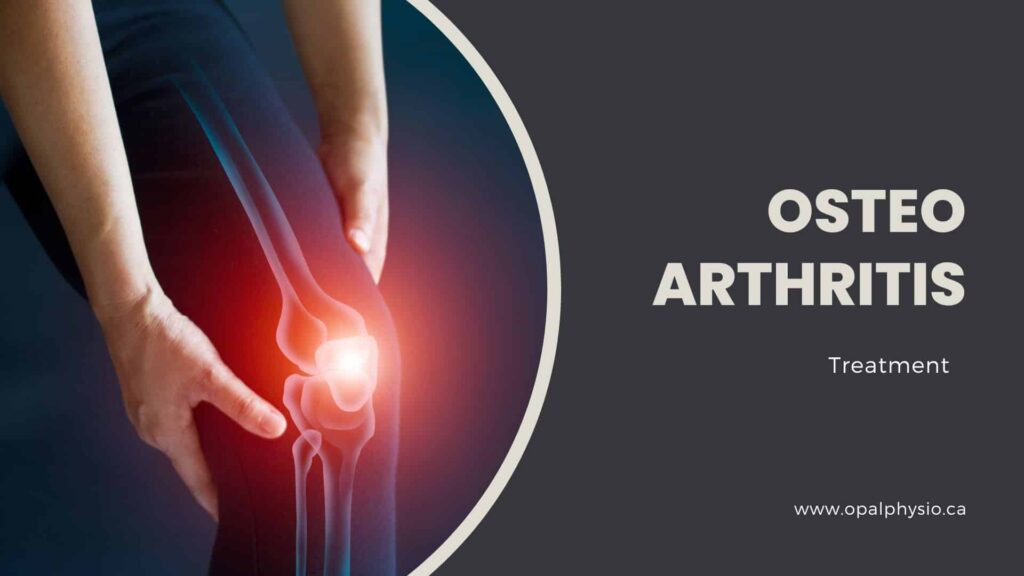Osteoarthritis Physiotherapy Treatment in Langley
Osteoarthritis (OA) is a degenerative joint disease that causes pain, stiffness and reduced joint mobility from changes in articular cartilage. It is more common in older adults and can cause pain and limit activities of daily life.
Physiotherapy treatment can help improve the range of motion, muscle strength, mobility and balance. At Opal Physiotherapy Clinic, our physiotherapists help you manage your symptoms and regain mobility with personalized treatment plans.

Symptoms of osteoarthritis
Osteoarthritis is the most prevalent form of joint-related chronic disease. Damage to the joint cartilage or its gradual degradation leads to OA. The condition can affect any joint, but it most often occurs in weight-bearing joints such as the knees, hips, spine (cervical/lumbar), or hands. Common symptoms include:
- Joint pain and stiffness
- Morning pain
- Swelling around the joints
- Reduced range of motion
- Joint crepitus: Grinding or cracking sounds during joint movement
- Difficulty weight bearing and performing daily activities, such as squatting, walking or climbing stairs
Osteoarthritis risk factors
OA is the most frequent disorder that affects the cartilage and bone, leading to joint pain and stiffness. Risk factors for OA include:
- Aging,
- Obesity.
- Family history of OA.
- Previous injury to a joint.
- Repetitive use of a particular joint, such as from playing sports.
Types of osteoarthritis
Primary osteoarthritis is the most common form of the disease. It is not associated with trauma or disorders but is much more likely to be diagnosed in patients with the above risk factors. Primary OA is typically caused by wear and tear on the joint.
Secondary osteoarthritis results from a pre-existing condition, disease or injury.
Causes of osteoarthritis
Though all the causes of this degenerative joint disease are not entirely understood. Many factors may contribute to the development of OA, including the following:
Physiotherapy treatment for osteoarthritis in Langley
Physiotherapy is an integral part of treatment for osteoarthritis management and can help reduce pain and optimize function for as long as possible.
Comprehensive treatment options
We offer a variety of physiotherapy treatments for OA, including:
- Manual therapy: Hands-on techniques to mobilize and manipulate the joints, reducing pain and improving flexibility.
- Exercise programs: Customized exercise plans to strengthen the muscles around the affected joints, enhance mobility, and promote overall health.
- Patient education: Patient education is an essential part of OA management. Our therapist can teach you how to use joints properly, exercise correctly in both motion and flexibility exercises, recommend assistive devices, recommend the use of modalities such as heat or cold therapies, TENS, etc.
- Bracing: Knee bracing can help reduce pain and improve function in patients with knee OA. Our therapist can make recommendations based on the assessment findings.
- Other modalities: Other modalities, such as thermal modalities, laser therapy, therapeutic ultrasound, electrical stimulation, and taping, among others, may also be used to manage OA symptoms.
Benefits of physiotherapy for osteoarthritis
Our physiotherapy treatments can help you:
- Improve joint flexibility and strength
- Reduce pain and inflammation
- Prevent further joint damage
- Enhance your overall quality of life
Our unique approach
At Opal Physio, we use cutting-edge techniques and equipment to provide the most effective OA treatments, including:
- Advanced manual therapy techniques
- State-of-the-art exercise and rehabilitation equipment
- Innovative electrotherapy devices
Take the first step towards pain-free living
Don’t let osteoarthritis hold you back any longer. Please book an appointment with our expert physiotherapists today, or contact us for more information on how we can help you regain your mobility and live pain-free.
Frequently Asked Questions
How do I know if I have osteoarthritis?
You may have osteoarthritis if you’re experiencing joint pain, stiffness, swelling, or reduced range of motion. However, a healthcare professional, such as a physician, should make a proper diagnosis, who can assess your condition and recommend the appropriate treatment.
How long does it take to see results from osteoarthritis physiotherapy?
The duration of treatment and the time it takes to see results can vary depending on the severity of your condition and your individual needs. Some patients may experience improvements within a few sessions, while others may require a longer treatment plan. Physiotherapists will work with you to develop a personalized plan that meets your specific goals and needs.
Will my insurance cover osteoarthritis physiotherapy treatments?
Many insurance plans cover physiotherapy treatments for osteoarthritis. It’s important to check with your insurance provider to determine your coverage and any out-of-pocket expenses you may be responsible for.
Do I need a referral from my doctor to receive physiotherapy for osteoarthritis?
In most cases, you do not need a referral from your doctor to see a physiotherapist for osteoarthritis treatment. However, some insurance plans may require a referral, so it’s best to check with your provider.
Can physiotherapy help with other types of arthritis besides osteoarthritis?
Yes, physiotherapy can benefit various types of arthritis, including rheumatoid arthritis, psoriatic arthritis, and ankylosing spondylitis. Physiotherapists will develop a tailored treatment plan based on your condition and needs.
Are there any side effects or risks associated with osteoarthritis physiotherapy treatments?
Physiotherapy treatments for osteoarthritis are generally safe and non-invasive. However, as with any treatment, there may be minor side effects, such as temporary soreness or discomfort following a session or exercise. Physiotherapists will monitor your progress and adjust your treatment plan to minimize potential risks or discomfort.
You may be interested in 7 Self Help strategies for Painful Hip and Knee Osteoarthritis.
